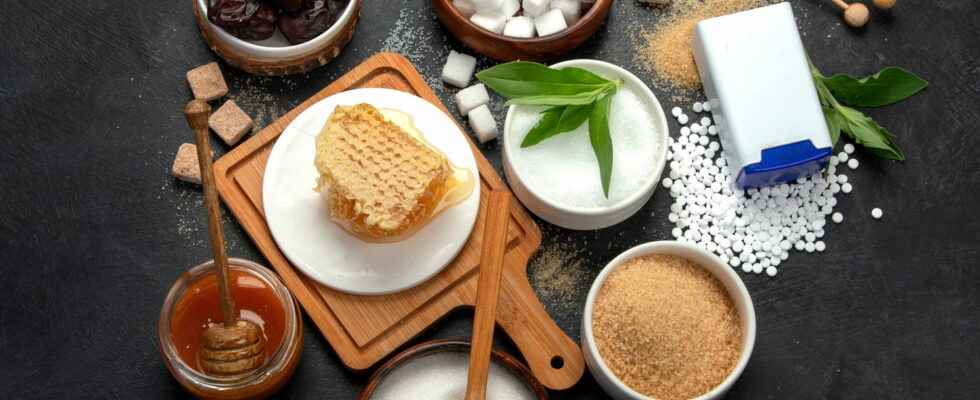Found mainly in fruits and honey, fructose has long been considered a “healthy” sugar. But its consumption in excess presents many health dangers.
Fructose is a naturally occurring sugar which differs from glucose. Fruits and honey contain it in large quantities. Its excessive consumption presents dangers to the liver and people with diabetes. Fructose is also one of the Fodmapsmall carbohydrates that are difficult to digest for people with irritable bowel syndrome (IBS). What foods contain fructose? What dangers for health ?
Definition: what is fructose?
Fructose is a simple sugar (or ose) of natural origin present mainly in fruits and honey. Its glycemic index (ability to raise blood sugar levels) is lower than glucose and it would be a little less cariogenic (cavity formation).
What foods contain fructose?
Fructose is present in its simple and natural form in honey and fruits. But we also find it in many other foods as sucrose (diose composed of glucose-fructose) which is “table sugar” or food additives (drinks and industrial sweet products). Indeed, its relatively low cost makes it one of the favorite sugars of the food industry and it thus appears in a very large number of processed products commonly consumed in the form of glucose-fructose syrup. The food richest in fructose is Honey with 40% fructose followed by fruits like dried fruits (grapes, figs, dates) which contain 30%, dates and fresh figs (25%), dried apricots and prunes (12%), pear (6%), cherries and ripe banana (5%) and kiwi (4%).
Is fructose dangerous for health?
The dangers of fructose are related to excessive consumption. Present as we have seen in many foods, including industrial ones, it can quickly be consumed in excess. Fructose is metabolized in the liver, where it is converted into glucose, glycogen, lactate and fatty acids. Overconsumption then leads to hypertriglyceridemiafatty deposits in the liver and muscles, and decreased hepatic insulin sensitivity. The effects of fructose on blood lipids are observed for ingested quantities of 50-100 g/day. A reduction in fructose intake is therefore desirable for people who are overweight, diabetic and at risk of cardiovascular disease. Prevention efforts should also target high consumers of fructose, exposed to increased metabolic risks (adolescents consuming sugary drinks in large quantities, for example).
Is fructose good for health?
Associated with the consumption of fruit and without excess, fructose, in its natural form, has a health connotation. Its higher sweetening power than sucrose also makes it possible to limit the amount of sugar in the preparations and therefore reduce calories.
How many calories for fructose?
100 grams of this food represents an energy value of 399 calories or kilocalories (or 1,700 kilojoules). On average, products in the sugars, sweeteners and honey category provide energy value equivalent to 327 kilocalories.
What to do in case of fructose intolerance?
As seen above, fructose is found in several forms in foods. Either alone, or combined with glucose in sucrose, or with other fructose molecules to form fructans. In case of fructose intolerance, it will then be necessary limit all foods containing these three categories. Either :
- Honey, cane sugar syrups, corn syrup, fructose syrup, glucose-fructose syrup, fructose-glucose syrup, table sugar (sucrose), agave sugar syrup, beet, various sugars…
- THE sweeteners : sorbitol, maltitol, mannitol, xylitol, isomalt, taggatose, sucralose, saccharin…
- industrial products
- THE fruits except citrus fruits
- THE wheat, barley and rye (rich in fructans)
- THE onions, garlic and artichokes (rich in fructans)
- THE legumes : lentils, weights, chickpeas, dried beans …. (rich in fructans)
- THE fructan-rich vegetables (artichoke, asparagus, beans, broccoli, cabbage, chicory, leek, onion, tomato, zucchini)
Does fructose raise blood sugar?
Although having a less effect on blood sugar than white sugar, it nevertheless remains to be limited, particularly in people with diabetes, especially in the form of industrial sugary products or drinks. The recommended fruit intake for a diabetic person is 300 g/d, i.e. about 2 fruitwhile it is to be limited to 400 g/day about 3 fruits, without diabetes.
